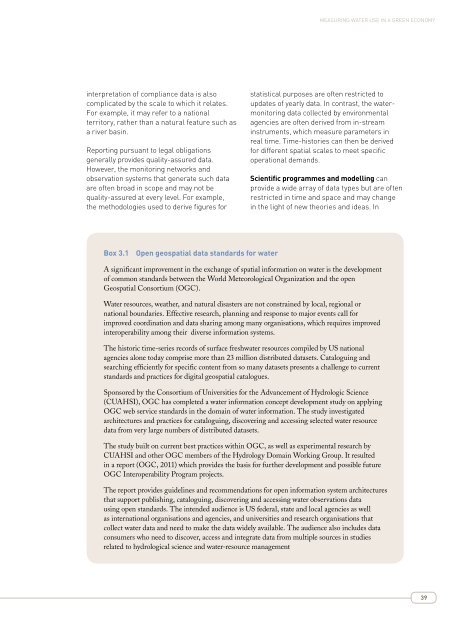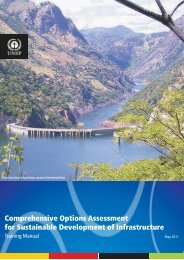MEASURING WATER USE IN A GREEN ECONOMY - UNEP
MEASURING WATER USE IN A GREEN ECONOMY - UNEP
MEASURING WATER USE IN A GREEN ECONOMY - UNEP
You also want an ePaper? Increase the reach of your titles
YUMPU automatically turns print PDFs into web optimized ePapers that Google loves.
Measuring water use in a green economy<br />
interpretation of compliance data is also<br />
complicated by the scale to which it relates.<br />
For example, it may refer to a national<br />
territory, rather than a natural feature such as<br />
a river basin.<br />
Reporting pursuant to legal obligations<br />
generally provides quality-assured data.<br />
However, the monitoring networks and<br />
observation systems that generate such data<br />
are often broad in scope and may not be<br />
quality-assured at every level. For example,<br />
the methodologies used to derive figures for<br />
statistical purposes are often restricted to<br />
updates of yearly data. In contrast, the watermonitoring<br />
data collected by environmental<br />
agencies are often derived from in-stream<br />
instruments, which measure parameters in<br />
real time. Time-histories can then be derived<br />
for different spatial scales to meet specific<br />
operational demands.<br />
Scientific programmes and modelling can<br />
provide a wide array of data types but are often<br />
restricted in time and space and may change<br />
in the light of new theories and ideas. In<br />
Box 3.1 Open geospatial data standards for water<br />
A significant improvement in the exchange of spatial information on water is the development<br />
of common standards between the World Meteorological Organization and the open<br />
Geospatial Consortium (OGC).<br />
Water resources, weather, and natural disasters are not constrained by local, regional or<br />
national boundaries. Effective research, planning and response to major events call for<br />
improved coordination and data sharing among many organisations, which requires improved<br />
interoperability among their diverse information systems.<br />
The historic time-series records of surface freshwater resources compiled by US national<br />
agencies alone today comprise more than 23 million distributed datasets. Cataloguing and<br />
searching efficiently for specific content from so many datasets presents a challenge to current<br />
standards and practices for digital geospatial catalogues.<br />
Sponsored by the Consortium of Universities for the Advancement of Hydrologic Science<br />
(CUAHSI), OGC has completed a water information concept development study on applying<br />
OGC web service standards in the domain of water information. The study investigated<br />
architectures and practices for cataloguing, discovering and accessing selected water resource<br />
data from very large numbers of distributed datasets.<br />
The study built on current best practices within OGC, as well as experimental research by<br />
CUAHSI and other OGC members of the Hydrology Domain Working Group. It resulted<br />
in a report (OGC, 2011) which provides the basis for further development and possible future<br />
OGC Interoperability Program projects.<br />
The report provides guidelines and recommendations for open information system architectures<br />
that support publishing, cataloguing, discovering and accessing water observations data<br />
using open standards. The intended audience is US federal, state and local agencies as well<br />
as international organisations and agencies, and universities and research organisations that<br />
collect water data and need to make the data widely available. The audience also includes data<br />
consumers who need to discover, access and integrate data from multiple sources in studies<br />
related to hydrological science and water-resource management<br />
39

















